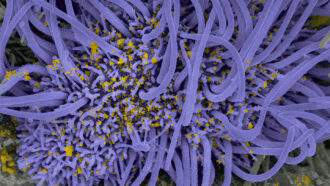
A coronavirus infection can mow down the forests of hairlike cilia that coat our airways, destroying a crucial barrier to keeping the virus from lodging deep in the lungs.
Normally, those cilia move in synchronized waves to push mucus out of the airway and into the throat. To protect the lungs, objects that don’t belong — including viral invaders like the coronavirus — get stuck in mucus, which is then swallowed (SN: 9/15/20).
But the coronavirus throws that system out of whack. When it infects respiratory tract cells, the virus appears to clear tracts of cilia, and without the hairlike structures, the cells stop moving mucus, researchers report July 16 in Nature Communications.
That lack of cilia could help the virus invade the lungs and cause severe COVID-19, says Lisa Chakrabarti, a viral immunologist at the Pasteur Institute in Paris (SN: 6/11/20). Understanding how the coronavirus invades different parts of the body can help researchers find ways to block it.
Chakrabarti and colleagues infected lab-grown human cells that mimic the lining of the respiratory tract with the coronavirus. Images showed short, stubby cilia on the surface of the infected cells rather than the long projections found on healthy cells. When the team added microscopic beads to the surface of infected cells to measure mucus movement, those beads largely stayed still — a sign that the cells wouldn’t move mucus through the respiratory tract and into the throat to be swallowed.
Other viruses and bacteria can also damage the body’s ability to use mucus to trap and remove foreign invaders, Chakrabarti says. Some pathogens, like the coronavirus, just damage cilia, leaving the cells they protrude from intact. Other pathogens — like influenza — can kill ciliated cells. Respiratory syncytial virus, which typically causes colds, can do both: In adults, it destroys cilia; in children, it can kill the cells, which can be deadly.


